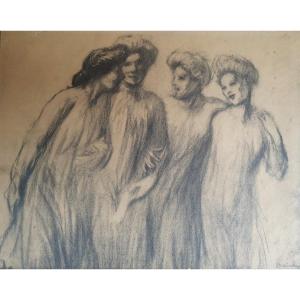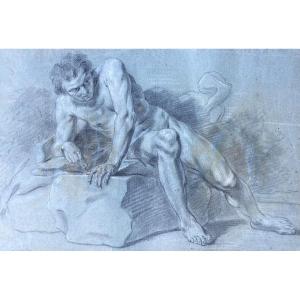This episode from Antiquity has come down to us thanks to the accounts of many ancient authors, first and foremost Titus Livius and Plutarch. The action takes place in the year 508 BC, barely a year after the birth of the Roman Republic. Rome is besieged by Etruscan troops led by their king Porsenna (seated on a country throne brandishing his scepter, left) and the city, starving, is ready to surrender to the enemy. A young patrician named Caius Mucius, wanting to save the city, proposes to the senate to pass through the enemy lines dressed in rags so as not to be spotted and to approach the king in order to kill him with a dagger… Launched into his heroic enterprise without knowing who the king is, Mucius spots a richly dressed man to whom all the soldiers turn. Convinced that this was his target, he pounces on him and deals him a mortal blow. Alas, he has just killed Porsenna's secretary and soldiers restrain him to take him before the king who immediately orders him to be tortured. But Mucius, calm, invites him to watch, so that he will know how much those who dream of glory can despise their body. He places his hand on the brazier lit for the sacrifice (in the center of the drawing) and watches it burn as if he were insensitive to pain. Moved by such heroism, Porsenna orders that the hero be removed from the altar and set free. Frightened by the idea of having to thwart incessant assassination attempts, Porsenna concludes a peace treaty with the Romans. And the Senate rewards Mucius by offering him lands beyond the Tiber. Our hero, having lost the use of his right hand, earns the nickname Scaevola, the Left-Handed. The artist, an 18th century Italian painter, composes the scene with a confident and lively stroke, applying shadows in ink with subtlety. The great ease he demonstrates offers the eye an image endowed with real virtuosity. This heroic episode illustrating bravery inspired many compositions by the most illustrious painters such as Peter Paul Rubens, Charles le Brun, François Boucher and Giambattista Tiepolo.
Presented under a mat with a green wash, under anti-reflective and anti-UV glass, framed with a Bérain style baguette.
Dimensions: 19 x 26 cm per sheet – 35 x 49 cm with the frame
























 Le Magazine de PROANTIC
Le Magazine de PROANTIC TRÉSORS Magazine
TRÉSORS Magazine Rivista Artiquariato
Rivista Artiquariato
